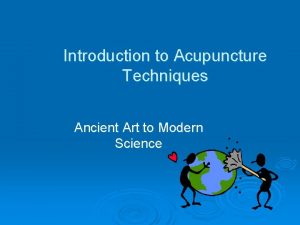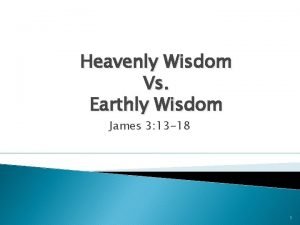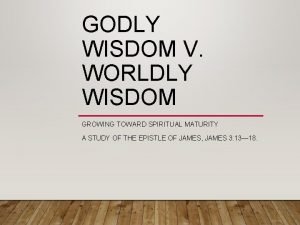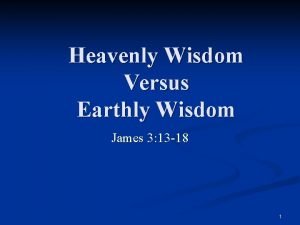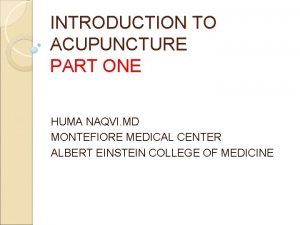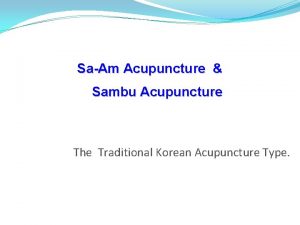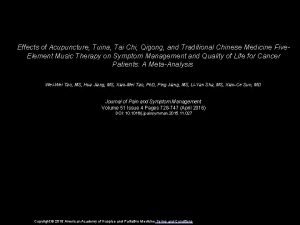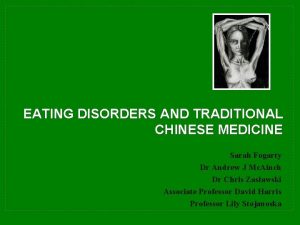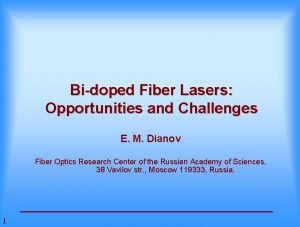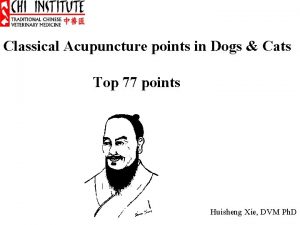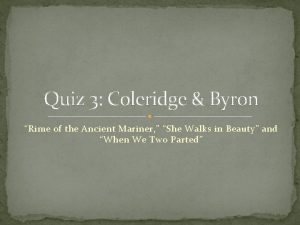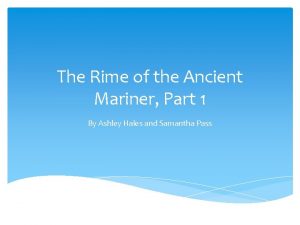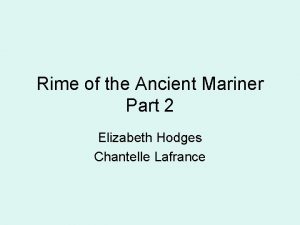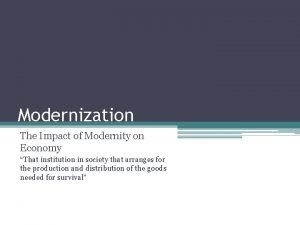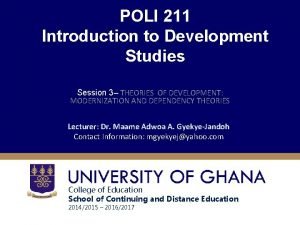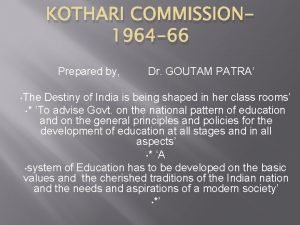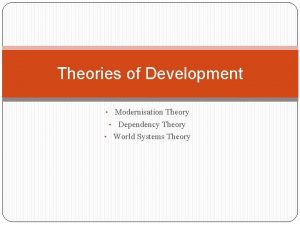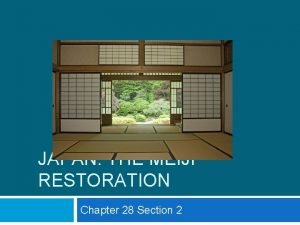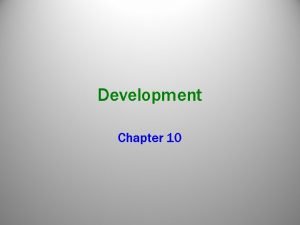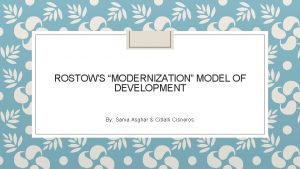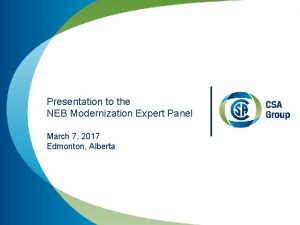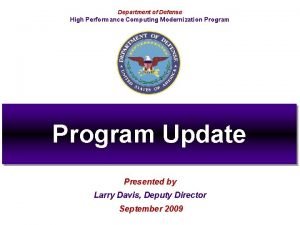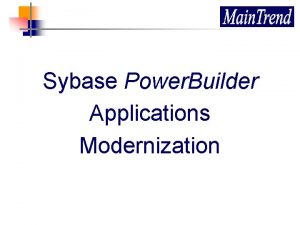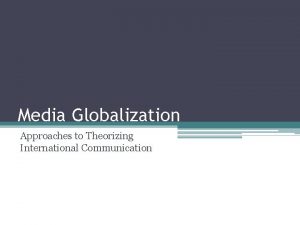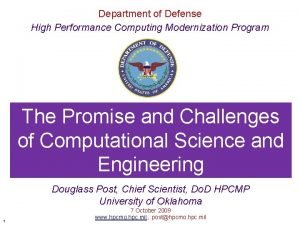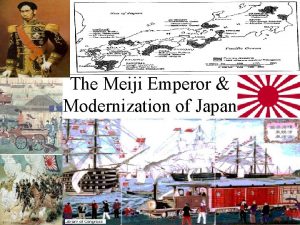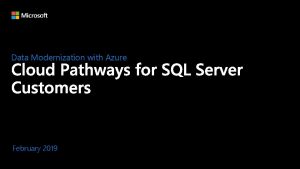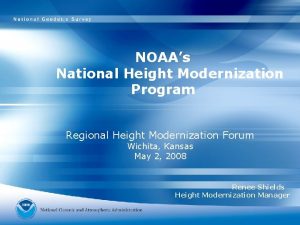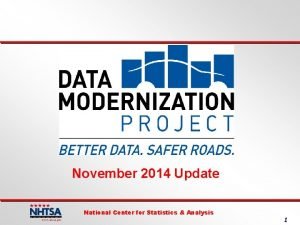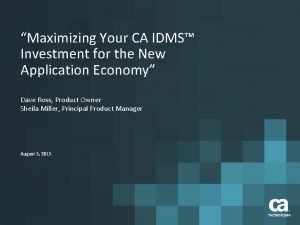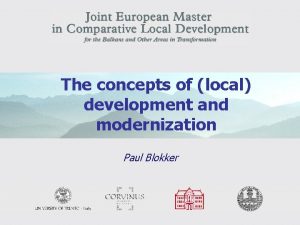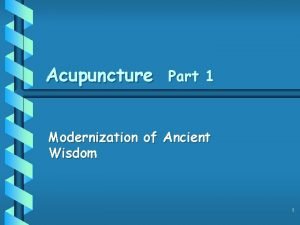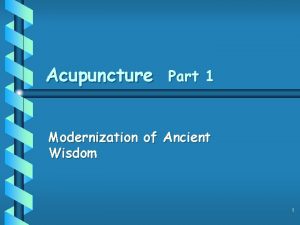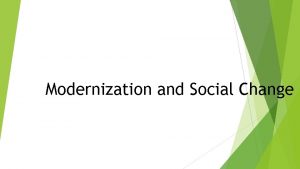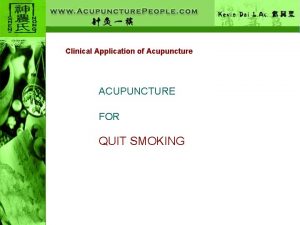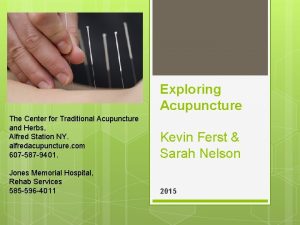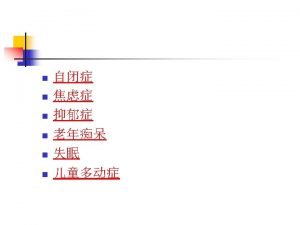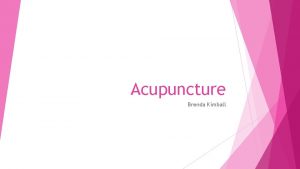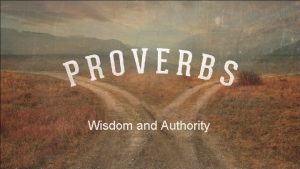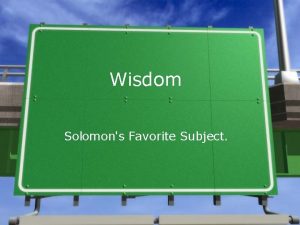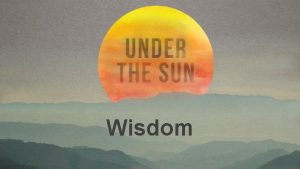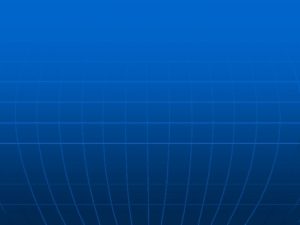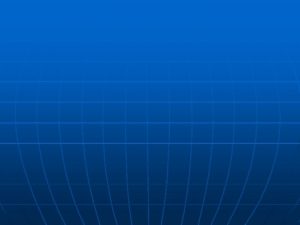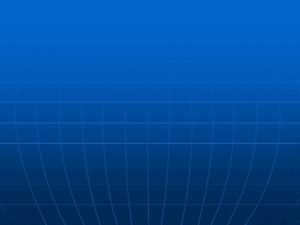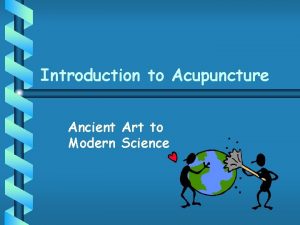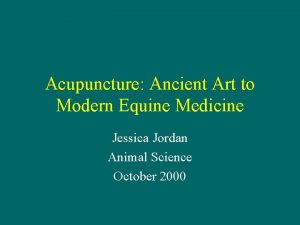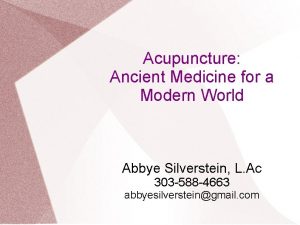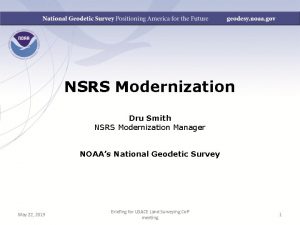Acupuncture Part 1 Modernization of Ancient Wisdom 1














































- Slides: 46

Acupuncture Part 1 Modernization of Ancient Wisdom 1

Comparison of East & West East b b b Empirical Observations over Thousands of Years Art of Medicine Holistic View Circular Logic Energetic West b b b Scientific Method & Case-Based Medicine Technology of Medicine Molecular and Organ View Linear Logic Mechanistic 2

What is Acupuncture? b b Acus meaning needle Pungare meaing to pierce Zhenjiu meaning needle (zhen) and moxabustion (jiu) Manipulating body balance through regulating flow of Qi 3

Moxabustion b Applied either moxa or heated element (1500° F) to arthritic joints • Moxa burned in room b Moxa was better & longer lasting 4

Scientific Evidence ? 5

What Scientific Evidence Exists? 18000 16000 14000 12000 10000 8000 6000 4000 2000 0 Number of Cites b Total Medline Cites for Acupuncture to Date Represents 16080 Publications 2605 Scientific Studies Acupuncture Cites on Pub. Med 1966 1968 1970 1972 1974 1976 1978 1980 1982 1984 1986 1988 1990 1992 1994 1996 1998 2000 2002 2004 2006 2008 2010 b Year 6

Animal Acupuncture Studies b b b Represent 1/10 th of all Cites Parallel Human Acupuncture Studies in Frequency No Double-Blind Studies 7

Placebo Effect b b Study showed that, if something specific is measured, then there is no placebo effect. Only if the measure is subjective. So, “blindness” may not be valid in all cases. 8

NIH ‘ 97 Consensus on AP b Effective for Osteoarthritis and Musculoskeletal Pain b Effective for many GI Problems • IBD, diarrhea, ulcerative colitis, peptic ulcers, dyspepsia, abdominal pain, nausea and vomiting b Effective for Pulmonary disease • asthma, colds 9

NIH ‘ 97 Consensus on AP b Effective for Immunomodulation b Effective for Reproductive • reduces inflammation, elevates WBC, interleukin-2 production Disorders • uterine bleeding, ovulation 10

How Does AP Work? b The physiologic effects of acupuncture therapy cannot be explained by a single mechanism, but rather a series of interactions among the • Nervous System • Endocrine System • Immune System 11

AP Events b b b Simple in concept, complex in action Starts from Local Effects Expands to involve the entire Neural Axis 12

AP Events b b Local effects Segmental effects • Pain control • Organ effects b b Central effects All take place at once 13

Basic Tenets of AP b b Based upon the AP point selected Based upon the method of stimulation • • Dry needles Electrical AP Aquapuncture Hemoacupuncture b b Based upon the length of stimulation Low-rate, twisting stimulation of GV 26 leads to endorphin response, while highfrequency needling of GV 26 leads to epinephrine response 14

Effects of Acupuncture b Using manganeseenhanced f. MRI (functional magnetic resonance imaging), visual effects can be seen in human and animal neural tissues Baseline Mn Infusion Mannitol EA GB 34 15

Effects of Acupuncture b b Activation of cortex is site specific GB 34 ST 36 Leads initially to specific effects 16

Effects of Acupuncture b b b Activation has temporal effects 5 minutes 20 minutes Longer stimulation activates more cortical structures Leads to broader effects 17

Effects of Acupuncture b In separate study, analgesic AP points were compared to nonanalgesic points • Analgesic AP altered brain regions involved in pain modulation – PAG, Mn. R, hypothalamus, thalamus • Non-Analgesic AP did not activate same areas 18

Method of Stimulation b b Stimulation of BL-20 (the SP association point) in horses led to analgesia using dry needles or electrical AP. Only EA increased release of endrophins into the blood. 19

Medication Timing & TCM 24 -hour Clock 20

Anatomical Considerations b Acupuncture point b Meridians b Reflex Connections b Central Connections 21

Shu Xue (communication outlet) Electrical resistance b Electrical conductivity b High density of b • • free nerve endings arterioles lymphatic vessels mast cells 22

AP Point b b b High levels of connexin 26 and connexin 43 densities b Microvascular bifurcated densities High oxygen pressure sensors Calcitonin gene related peptide (CGRP)-positive 23

AP Point Locations b b Points where neurovascular bundles where nerves penetrate the body fascia Points where nerves bifurcate 24

AP Points- -Bladder Meridian b Inner and Outer Bladder Meridian Points 25

Acupuncture points: 4 types b Type I: motor point; 67% of all the points • maximal contraction with minimal intensity of stimulation • the nerve enters the muscle • LI-4 ( He-gu) b Type II: dorsal & ventral midline • superficial nerves in the sagittal plane • #68 (Bai-hui) 26

Acupuncture points: 4 types b Type III: superficial nerves / nerve plexuses • GB-34: common peroneal nerve (deep & superficial branches) • PC-6: over the median nerve b Type IV: Muscle tendon junctions • Golgi tendon organ • BL-57: gastrocnemius 27

Hemo. Acupuncture Points b b Most AP points are associated with vascular elements (veins) Blood vessel walls (veins) appear to have AP points directly on or in them 28

Anatomical Considerations b Acupuncture point b Meridians b Reflex Connections b Central Connections 29

Meridians: Myth or Reality? b Close correlation between • AP Meridian • Peripheral Nerve Pathways b Meridians appear to possess bioelectric function similar to PN b Meridians follow PN • • Lung (LU) = Pericardium Musculocutaneous N (PC) = Median N 30

Meridian Research b b Stimulation of AP points on meridian lower resistance at other meridian points Injection of radioisotopes into one point gradually accumulates at other points b Radio signals places over one AP point can be picked up at other AP points along the meridian 31

14 Major Meridians b b b b Lung Meridian: LU b Heart Meridian: HT b Pericardium M. : PC b Spleen Meridian: SP b Liver Meridian: LIV b Kidney Meridian: KID b Conception Vessels: CV b Large Intestines M. : LI Small Intestines M. : SI Triple Heater M. : TH Stomach Meridian: ST Gallbladder M. : GB Bladder Meridian: BL Governing Vessels M. : GV 32

Meridians b Energy flow system b Chi (Qi): energy flow b AP points on 14 major meridians b Normal: Energy flow all the time on all the meridians from one acupuncture point to another LU->LI->ST->SP->HT->SI->BL->KID->PC->TB->GB->LIV 33

Meridians b Where is pain. there is no free flow, there Pathogenic factors Meridian No free flow Pain 34

Meridians b Where there is free flow, there is no pain. Pain Pathogenic factors No free flow Meridian Acupuncture Stimulation Eliminating Meridian Normal 35

Anatomical Considerations b Acupuncture point b Meridians b Reflex Connections b Central Connections 36

AP Effects b Needle insertion stimulates afferent A-delta nociceptive fibers which leads to • Local Effects • Spinal Cord Effects • Brainstem Effects 37

Acupuncture Pathway b AP Stimulus is carried by afferent peripheral nerve • • Can be blocked by Procaine No AP analgesia on paralyzed limbs (somatosensory paralysis) • Most profound AP analgesia is from points overlying major peripheral nerves 38

Acupuncture Pathway b b Stimulus enters the spinal cord Integrated information ascends the spinal cord to the brainstem, thalamus and cerebral cortex 39

Gate Theory of Pain 40

Acupuncture & Pain b Responses • • to heat electricity pinprick pinch AP Naloxone PT Analgesia 41

EA: Effect of Increasing Frequency 200 Hz 4 Hz 0. 2 Hz Electrical Acupuncture 42

EA: Low Frequency ± Naloxone Electro-acupuncture 4 Hz + saline 4 Hz + Naloxone 43

EA: High Frequency ± Naloxone Electro-acupuncture 200 Hz + saline 200 Hz + naloxone 44

Mediators of AP Analgesia b Enkephalins Cord (Substantia Gelatinosa) b Endorphins Gray Matter) b 5 HT & Dynorphins Spinal Brainstem (Periaqueductal Brainstem (Raphe Nuclei) 45

AP Analgesia b b b Varies among patients (species specific) Varies from location of AP point Varies with proximity to AP point 46
 Liao yuan
Liao yuan Earthly wisdom meaning
Earthly wisdom meaning Godly wisdom vs worldly wisdom
Godly wisdom vs worldly wisdom Earthly and heavenly wisdom
Earthly and heavenly wisdom Acupuncture
Acupuncture Saam acupuncture book
Saam acupuncture book Kung fu panda acupuncture
Kung fu panda acupuncture Sarah fogarty
Sarah fogarty Al500 acupuncture laser
Al500 acupuncture laser Liv3lo
Liv3lo Urge incotinence
Urge incotinence Ancient and modern means of communication
Ancient and modern means of communication Ancient india vs ancient china
Ancient india vs ancient china The rime of the ancient mariner part 3
The rime of the ancient mariner part 3 The rime of the ancient mariner part 3
The rime of the ancient mariner part 3 Rime of the ancient mariner quiz
Rime of the ancient mariner quiz The rime of the ancient mariner shmoop
The rime of the ancient mariner shmoop The rime of the ancient mariner part 2
The rime of the ancient mariner part 2 Conclusion of modernization
Conclusion of modernization Criticism in
Criticism in Kothari commission conclusion
Kothari commission conclusion Dependency theory
Dependency theory Illinois height modernization
Illinois height modernization Chapter 28 section 2 modernization in japan
Chapter 28 section 2 modernization in japan Modernization vs globalization
Modernization vs globalization Height modernization programs
Height modernization programs Modernization theory
Modernization theory 5 stages of rostow's model
5 stages of rostow's model Neb
Neb High performance computing modernization program
High performance computing modernization program Powerbuilder modernization
Powerbuilder modernization Media imperialism
Media imperialism Modernization in japan
Modernization in japan High performance computing modernization program
High performance computing modernization program Modernization in japan
Modernization in japan Modernization
Modernization Data modernization to azure
Data modernization to azure Height modernization programs
Height modernization programs Role of rrrlf in modernisation of libraries
Role of rrrlf in modernisation of libraries Bdm esdc
Bdm esdc Backup modernization
Backup modernization Oracle forms modernization
Oracle forms modernization Nhtsa data modernization
Nhtsa data modernization Accelerate data center modernization
Accelerate data center modernization Idmsx modernization
Idmsx modernization Financial modernization act of 1999
Financial modernization act of 1999 Conclusion of modernization
Conclusion of modernization
